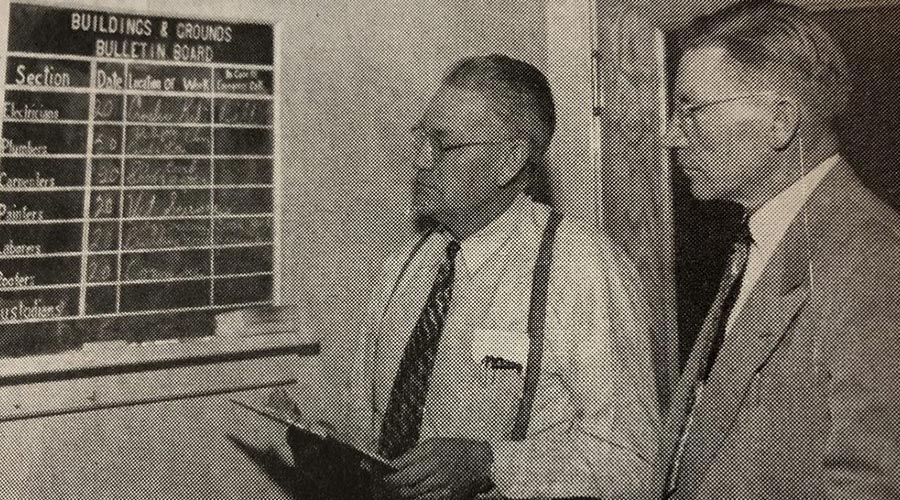Good help is hard to find. Managers offer insights into locating quality candidates
OTHER PARTS OF THIS ARTICLEPt. 1: This Page

• Sean Devaney, District Director of Maintenance, Mechanical and Electrical Systems, Broward College, Davie, Fla.

• Greg Clark, Senior Director, Facilities Maintenance and Operations, Wake County Public Schools, Raleigh, N.C.

• Chris Miller, Director of Facilities Services, Georgia Regents Medical Center, Augusta, Ga.
Given a shortage of candidates, maintenance and engineering managers struggle to find front-line technicians with the skills and experience necessary to protect and improve the condition of institutional and commercial facilities. In this Roundtable, managers address the essential elements of recruiting quality maintenance technicians.
Question: Where does technician recruiting fall on your daily priority list, and is it rising or falling in priorities?
DEVANEY: My recruitment priority differs depending on what openings I am looking to fill. At times, there are no openings, and suddenly I can be faced with one or several due to retirement, resignations, transfers, or termination. At this time, I have one opening I am looking to fill — a locksmith manager’s position. This is high on my priority list. I have recently extended the search to encourage additional applicants. Anytime there is an opening, it should be high on the priority list. My department performance is only as good as the staff I hire to become part of the facilities operations team.
CLARK: The actual recruiting and hiring process is pushed down a few levels from me to some of my department managers and directors. Where I get involved is more on strategizing and how we can attract quality candidates into our operation versus getting involved in the actual interviewing and hiring of technical staff.
MILLER: Technician recruiting is very high on our list of priorities. We were very fortunate for a long time to have very good retention, but I’ve seen our workforce really age. We’ve really lost some people to retirement and to health issues. Once, we were a pretty solid department where we had very little turnover, but it has now has become a day-to-day thing. It’s become very high on our list, primarily because we are doing so much more with less. Our gross square footage numbers have vastly increased over the last 10 years. However, our department has not. When we get a technician that leaves and goes elsewhere, that puts a big burden on our shoulders to fill that spot and to fill those duties. We work hard to fill that position as quickly as we can so we can spread the work out a bit more evenly with the rest of the technicians.
Question: Where have you had success in finding technicians for your department?
MILLER: To be specific to our market, we are surrounded by a lot of large manufacturing plants. We find those folks working in large manufacturing plants working shift work (and) working a lot of hours. They tend to burn out at those positions after a few years. We’ve been pretty fortunate recruiting those individuals. What’s great about that is they’ve got really good skill sets, and our day shift is primarily 8 to 5, which is a nice selling point to a lot of folks that have families and want to spend time with their families after work. We’ve found that the larger manufacturing plants have really lended to us some good technicians in the last five years.
DEVANEY: I look internally for candidates that may have the skills and desire to move up into new job responsibilities. For example, Trades I to Trades II, Trades III to supervisor, or supervisor into a management position. Beyond the normal recruitment process, which is handled by the human resources department, with advertisements placed in various publications and job search sites, I often provide links through Facebook and LinkedIn to get the word out. An additional important resource is to ask your team if they know of qualified candidates externally that they would recommend.
CLARK: We’ve worked with the military. There are a couple of large bases not too far from Raleigh. We’ve partnered with them where they can use us as a resource when they’re leaving the military. In many instances, some of the trades that have been learned in the military and disciplines translate pretty well into facility maintenance. We also work with the North Carolina Department of Labor. They have an apprenticeship program for electrical (workers), and we’ve partnered with them to put some folks through their program. We also partner with Wake Tech Community College in Wake County. Just a year ago, we opened a vocational technical high school in conjunction with the community college. I’ve been working with educational staff to see how we can leverage some of the course work they’re teaching in plumbing, HVAC, welding, and some of the things that we use in our day-to-day operations, and how we can establish a pipeline, a career path for folks that would be interested in coming out with certifications that are required of some of our staff. It’s a relatively new partnership where we’re basically operating on the same campus, but I’m hopeful it’s going to have some rewards for us.
Question: What strategies do you use to market your department to potential candidates?
DEVANEY: My best marketing strategy is to get candidates in to see the campus location where the position will be assigned, talk up the longevity of the majority of current staff, and discuss the many great benefits that are not typically found in the private sector, such as generous paid time off, health benefits, and (a) retirement pension. Walking the campus with candidates is always a great idea. It provides them with a sense of the culture on campus and a chance to see the buildings and grounds. It’s hard not to feel good when taking a walk on any of our campuses. I recently saw a landscape technician working at the U.S. Post Office. I was in and out several times on a hot Saturday morning. His work impressed me, so on the way out, I stopped and introduced myself, gave him my business card and asked for his resume. You never know when I will be looking for additional staff.
MILLER: We do like to emphasize that it’s an 8-to-5 job, Monday through Friday. We emphasize the benefits packages because we feel we have one of the better benefits packages in the area, and we do emphasize the ability for you to have a life outside of work and take part in your family activities. For most people, what I hear is they’re missing baseball games for their children, missing activities they want to be a part of as their children grow up. We also talk about holidays, have paid holidays. We do have a rotating holiday schedule, but we have enough technicians in the department so really, one technician may only have to work one holiday a year. We like to play those things up and give them a good idea of what we expect during 8 to 5 but (also) what they can expect once they leave here.
CLARK: We’re leveraging our vocational education program, speaking with the outsourcing staff from military bases, and trying to convince the younger folks coming into the work world that facility maintenance is a solid, long term, good profession to get into, and there’s a lot of growth potential, as well. We just try to make sure we get that word out, that there are significant career options, and they are good, well-paying careers to be had.
Question: What resources have been most helpful in improving recruiting effectiveness?
DEVANEY: I rely heavily on (our) human resources (department) to drive the recruitment process and time frame for each position. Additionally, I network by getting the word out there to my contacts at other institutions through coworkers and through some of my business partners. A door hardware vendor, for instance, may have a candidate in mind for a locksmith position. And again, I post the position through Facebook and LinkedIn.
CLARK: We partner with our community college system to leverage what we can in their programs, and (we) also send some of our staff to their continuing education programs. Trade shows continually provide us information on improving the offerings we have for technicians to keep their education current.
MILLER: Our human resources (HR) department does all our recruiting for us. Every applicant that comes to apply for a position has to go through a software system via the web, and they enter their information in, and our human resources department kind of takes it from there. We would love to see some things done differently, perhaps a little more widespread recruiting, more regionally would be nice, but our HR department calls the shots. We don’t have a whole lot of flexibility.
Question: What characteristics do you look for in prospective employees?
MILLER: The very first thing we’re looking for is good attitude. We love someone to come in with experience. We really do. But we’ll take attitude over experience any day of the week. It’s surprising because the job market is still very tight, but you find that there’s a lot of personalities that bring negative tones to the job. They even project that in interviews sometimes.
DEVANEY: (A candidate must) demonstrate commitment and longevity in past employment related to the position I am recruiting for.
CLARK: Definitely a stable work history and solid, solid work references. Both speak to the content of someone’s character. The understanding in our world is these technicians are in and around kids all day and every day. Our work isn’t always on the roof or in the boiler room. We have some very stringent protocols on who we hire and why. Some of that also plays into the level of technicians we’re looking for. Not all of our technicians require licensure or special certifications. We have a fairly significant group of facility maintenance technicians, but they’re really jack-of-all-trades guys.
Question: What lessons have you learned about the recruiting process?
DEVANEY: Take your time with the process. If I am not comfortable with the pool of candidates, then I extend the search until such time as the applicant pool improves. When interviewing, I am up front and honest with job duties and performance expectations. I let it be known that poor performance, attendance, or other adverse concerns will result in termination. Bring new hires in on an interim basis. It can save a lot of time and aggravation if the performance is not where it should be. The new hire comes in knowing it is on them to demonstrate consistent, positive performance.
CLARK: Work closely with your HR department, however your department is structured. Currently, the way we’re structured, it’s up to my staff to select, short-list, and interview candidates and make recommendations for hires to human resources. At some point, I would like to see that situation reversed. Human resources has the position description, so they can go find us people that meet these qualifications and make recommendations of folks we should interview. That would be a better use of resources. We’re not HR experts; we’re facility maintenance experts. My staff’s time is better utilized doing what they do, which is getting ahead of and mitigating facility-related issues in support of our educational customers.
MILLER: (Trying to) keep employees. This is something we’ve not faced before. The retention (rate) of the department was just very solid, but people are much more looking to change jobs than ever before in this type of market. We’ve done some employee surveys gauging satisfaction of the job because especially when we get good talent with good attitudes, we want to make sure that we’re nurturing those types of employees and providing good training for them. We don’t want to lose them because they’re hard to find. From (that) standpoint, what we’ve learned is not only how to recruit but how to keep them.
Related Topics:















